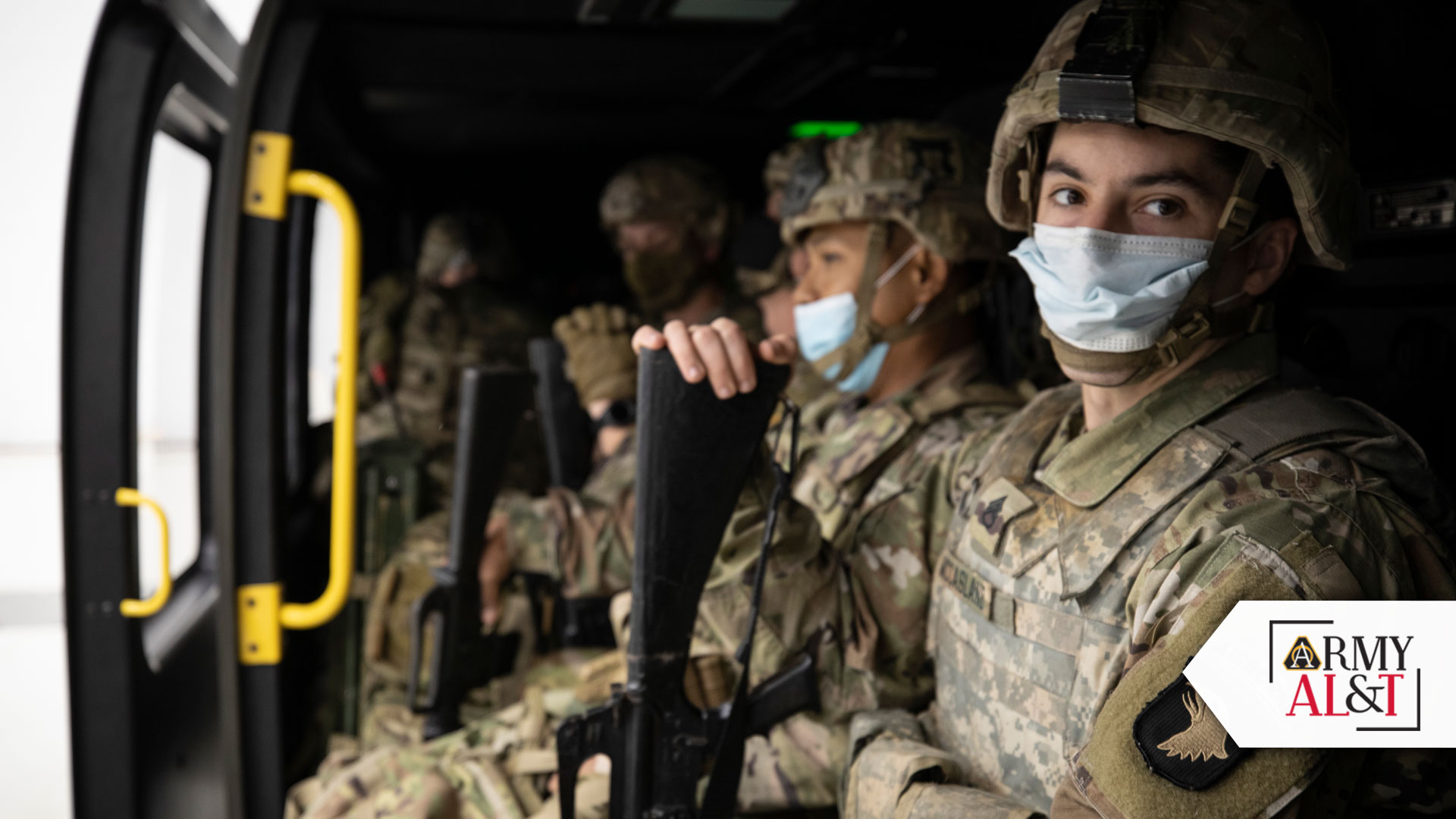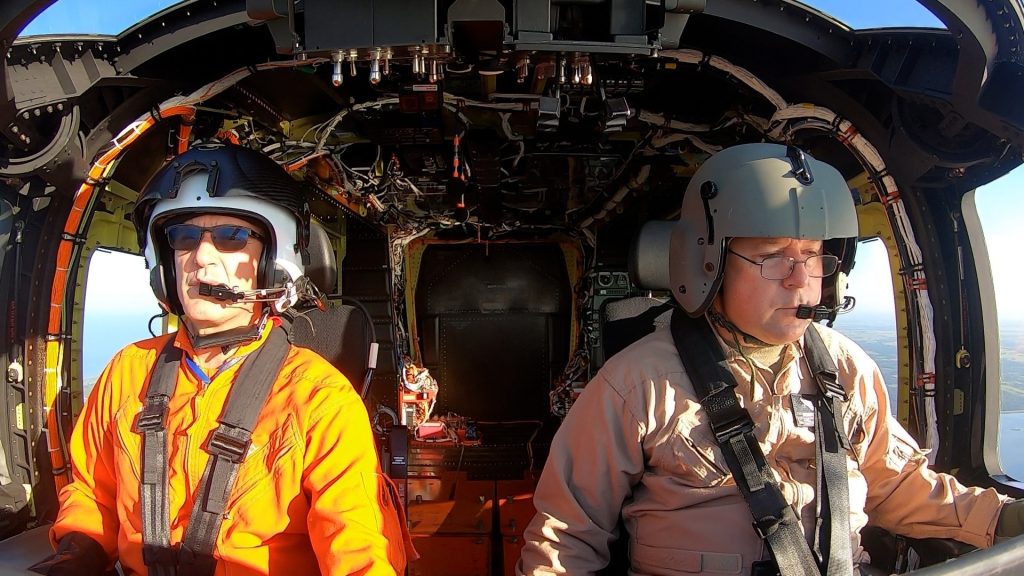
TEST RUN: Re-imagining Future Long Range Assault Aircraft means taking real data from flight tests and rigorously refining the requirements to meet the Army’s needs for flight performance, combat survivability, sustainability and safety. Photo courtesy of Lockheed Martin)
Along with Industry, the Army is taking a once-in-a-generation opportunity to imagine what vertical lift means for the Future Long Range Assault Aircraft.
by Col. David Phillips
Modernizing Army aviation is of monumental importance to our nation’s defense, and there is a great opportunity for the Army and industry to get it right. With the right balance of empowered professionals, innovative acquisition approaches and a set of optimized requirements, the Army has a once-in-a-generation opportunity to design, develop and deliver Future Vertical Lift (FVL) aircraft that are able to operate at far greater speeds and ranges to support our Soldiers in 2030 and beyond.
But, the Army cannot build a 21st century aircraft using the same tools and processes as it did with the venerable Black Hawk in the 1970s. Today, the stakes are high for the Army’s modernization strategy. National security, the industrial base and precious resources are at stake. And more importantly, future warfighters will need these modernized Army aviation capabilities to win on future battlefields. One of these capabilities is the Army’s Future Long Range Assault Aircraft; the next generation of affordable vertical lift aircraft with the primary mission of long range air assaults and aeromedical evacuation. Historically, the Army has typically had linear acquisition processes with industry during the requirements and design process. Working alongside the FVL Cross-Functional Team and with teams across the aviation enterprise, the Future Long Range Assault Aircraft Project Office—the early adopters of DOD’s Adaptive Acquisition Framework—are using new acquisition authorities and procedures to revamp a decades-old Army process to become leaner, faster and ultimately deliver advanced capabilities to Soldiers. Along with industry’s best and brightest, the Army is re-imagining what Future Long Range Assault Aircraft can be.
INVERTING THE DEFENSE PROCUREMENT PARADIGM
The Adaptive Acquisition Framework was described as “the most transformational acquisition policy change we’ve seen in decades,” by Ellen Lord, the former undersecretary of defense for acquisition and sustainment. Lord said that the framework allows for “innovative acquisition approaches that deliver warfighting capability at the speed of relevance.” As a key component of Army Aviation’s modernization strategy, the Future Long Range Assault Aircraft team is paving the way in leveraging authorities established in the framework, enabling the program to remain on schedule and meet the Army’s objectives through the use of a hybrid acquisition approach.
The program’s approach includes three main phases: risk mitigation activities using other-transaction authority agreements, rapid prototyping using middle tier of acquisition authorities and tailored major-capability acquisition weapons system development with a Milestone B in 2023.

NEXT GEN IN ASSAULT AND EVAC: The Future Long Range Assault Aircraft is the next generation of affordable vertical lift aircraft with the primary mission of long range air assaults and aeromedical evacuation. (Photo by Spc. Timothee Buangala, U.S. Army)
HOW IS THIS DIFFERENT?
Over the past two years, the Army engaged with industry through two other-transaction agreements, and conducted detailed trades analysis, reviewing hundreds of system specifications. This is a different approach from the past where the Army would define system specifications and send out for red line, getting only one opportunity for formal industry feedback on detailed requirements ahead of the request for proposal and formal design process.
Instead, the Future Long Range Assault Aircraft Project Office asked industry to assess key requirements and design attributes, and then do their part to demonstrate new ways to optimize cost, performance and schedule. With competitive demonstration and risk reduction , the Future Long Range Assault Aircraft Project Office is using digital engineering with industry to significantly reduce risk, reduce life-cycle costs and increase performance of these new weapons systems. The Army brought industry onboard early in the conceptual design process to help optimize requirements through numerous design iterations. The optimization of those designs and requirements before investments in major hardware and resources will ultimately drive affordability for the life cycle of the program.
Since 2020, the project office has executed two rounds of competitive demonstration and risk reduction, allowing the Army to leverage industry knowledge and optimize requirements through digital engineering prior to entering the final design, build and test of the weapons system. This means taking real data from flight tests that the Army has continued over the past two years with the Joint Multi-Role Technical Demonstration program and rigorously refining the requirements to meet the Army’s needs from flight performance, combat survivability, sustainability, safety—all of which enable affordability for the life cycle of the program. If the UH-60 Blackhawk is the benchmark, that could be over the next 50 years.

FOCUS ON AFFORDABILITY: Brig. Gen. Robert L. Barrie, Program Executive Officer for Aviation, speaks at the “Modular Open System Approach” Warriors Corner Speaker Session during AUSA 2021. The Future Long Range Assault Aircraft Project Office integrated the approach into its requirements to enable life cycle affordability. (Photo by Sgt. 1st Class Henry Gundacker)
Early collaboration between the Army and industry is also allowing the Army to influence innovation and competition, and it is offering more opportunities for Soldiers to provide valuable input into the final product during touch points. Army pilots have flown these new configurations, and both Army maintainers and infantry squads have provided invaluable feedback on the new approaches to sustainment and operations in the field.
The Army is embracing an adaptive acquisition framework that allows for tailoring before entry into major acquisition milestones and allows for the appropriate use of acquisition reform authorities. The project office’s use of mid-tier authorities accelerates capability maturation and allows for early development of virtual aircraft prototypes, focusing on maintaining program momentum with appropriate acquisition rigor.
With mid-tier acquisition, the focus is on balancing speed with rigor: requirements authorities and acquisition oversight are pushed down, and funding is provided for deliberate increments of capability through rapid prototyping. Ongoing technology risk reduction will continue by capitalizing on data from the flying demonstrators, test stands and wind tunnel models. Ultimately, virtual prototypes will further reduce risk to the program and set a strong foundation for future program success.

FORD PHENOMENON: A good example of revamping traditional methods is the Ford Mustang—a car that far exceeded expectations—selling over 400,000 in the first year, and over a million in the first 18 months. Proof of an optimized design that was ideally suited for the market.
Comparatively, the automobile industry has many examples of programs and innovations that have either been successful or failed. A similar thought process of revamping traditional methods came out of Ford Motor Company in the 1960s. Looking to develop a new sports car, Lee Iacocca faced multiple dilemmas, at the heart of which was one of the biggest losses in Ford history with the development of the Edsel. Driving against the tide of skepticism from senior executives, Iacocca and his team innovated. With constrained resources for development, Ford’s “Fairlane Committee” worked through more than 18 designs. Ultimately, it was the competition amongst Ford’s design teams that produced a great outcome. Ford’s final design was a proper balance between the performance, weight (approximately 2,500 pounds) and cost (approximately $2,500). In 1964, Ford built a car that far exceeded even their own expectations—the Mustang—selling over 400,000 in the first year, and over a million in the first 18 months. This was proof of an optimized design that was ideally suited for the market.
TRUST IS CRITICAL TO SUCCESS
For the Future Long Range Assault Aircraft, the Army is building both relationships and trust while getting multiple bites at the “requirements apple,” and counting on a much more rapid development path, proving technologies early with designs that strike a balance between performance and cost. With the goal of enabling life cycle affordability, the project office has deliberately integrated the modular open systems approach into its requirements and sustainment strategies. That modular approach is the Army’s emerging set of common standards and interfaces for aircraft electronics. It allows for rapid, cost effective upgrades and tailored mission systems, which ultimately drives long-term cost savings.
Over the past two years the Future Long Range Assault Aircraft Project Office, along with the Program Executive Office for Aviation, has invited industry, government partners and academia to the architecture-collaboration working group that helped to define the framework included in the Future Vertical Lift architecture framework. That architecture framework defines the objectives and requirements that the contractor shall uphold to execute a modular approach and deliver a product and capability that meets the new aircraft’s modular approach objectives. The architecture framework will improve the government’s ability to use appropriate data rights by enabling competitive, continuous upgrade and delivery of threat-based capability through faster fielding of innovation by using common processes, tools and standards.
Leading change always presents many challenges, even in the commercial industry. Lee Iacocca finally convinced Henry Ford II that a paradigm shift at Ford Motor Company would be the answer. There was no sports car in Ford’s portfolio. There were no plans to build one. The company tried to buy Ferrari, but that attempt failed. It also led to a series of history-making decisions. Ford’s innovation and willingness to change its business practices was not easy. While hardliners scoffed at the idea and worried they wouldn’t make a profit, Ford changed its script, and sales skyrocketed.

SPEED THINGS UP: With the right balance of government and industry resources, the Army has an opportunity to design, develop and deliver FVL aircraft that are able to operate at far greater speeds and ranges.
ACQUISITION NEEDS A NEW THOUGHT PROCESS
In 2018, the Army laid out a modernization strategy in line with the National Defense Strategy. Four years later, the Army is executing to this strategy, aligning with best commercial practices for design and requirements optimization and using cutting-edge digital engineering design tools to flesh out ideas, concepts and innovations before selecting the eventual builder of these aircraft in 2022.
Army leadership is fostering an environment where tailored acquisition strategies thrive, and senior leaders know the difference in associated risks between the rapid and deliberate processes. Acquisition professionals are ensuring this process fully involves experienced operators and sustainment professionals, embracing their feedback. While there is a healthy tension between the industry competitors who are looking to be selected to build the aircraft, competition will only drive us to a better, more affordable end-product.
CONCLUSION
Our nation’s challenges aren’t getting any easier. While we trust our nation’s strength will endure, and hopefully deter the next war, it will be a new era of Soldiers that will fight in the next major conflict. It is our responsibility in the Army to ensure Soldiers have the right equipment, the very best aircraft and lethal capabilities to win. Our mission is important, and with the changing environment, Army aviation may yet again be the first in harm’s way.
For large, complex organizations like the Army, adopting new models can be difficult and the barriers to change are often steep. With today’s realities, the Army cannot afford the luxury of historically long, drawn out acquisition timelines. Making informed decisions on requirements through design optimization will enable the Army to ensure FLRAA capabilities are affordable, meet multidomain operations requirements and deliver on an aggressive schedule that does not sacrifice rigor for speed.
Delivering next generation Army capabilities will require a new paradigm and a team of teams effort. We will succeed.
For more information, go to https://www.army.mil/article/239362/future_long_range_assault_aircraft_flraa.
COL. DAVID PHILLIPS is the current project manager for Future Long Range Assault Aircraft. He has an M.S. in aerospace engineering from North Carolina State University, a masters of strategic studies from the U.S. Army War College, and a B.S. in engineering physics from the United States Military Academy at West Point. He has completed Defense Acquisition University’s Executive Program Managers’ Course, is and Level III certified in program management.







